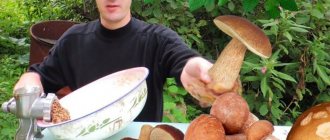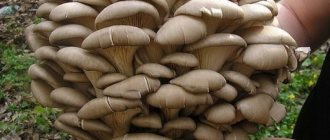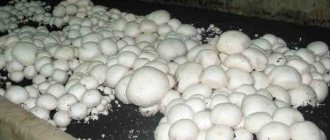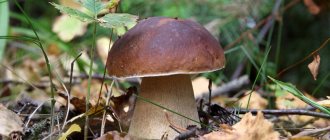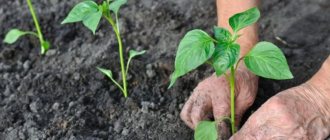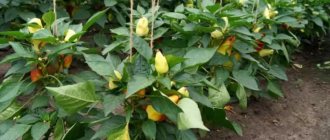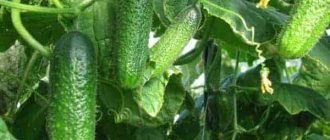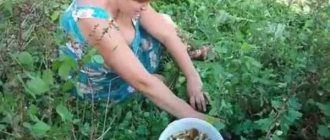If they tell you that growing oyster mushrooms is easy for beginners, don’t believe it. Knowing the theory is not enough. Practical experience is valuable. Many factors influence success, everything needs to be taken into account. This guide goes into detail about growing oyster mushrooms from scratch.
Before mastering mushroom growing, you need to understand the process from the inside and learn the technology for growing oyster mushrooms at home. The end result should be a commercial oyster mushroom mini-plantation ready for cutting. It is worth carefully studying how to properly grow mushrooms of this type indoors, as well as on stumps in the garden.
Oyster mushrooms: beneficial properties
Oyster mushrooms are valued for their nutritional and beneficial properties. These mushrooms are 70 percent protein, which is why they are sometimes called “mushroom meat.”
Oyster mushrooms contain fiber (chitin), which is useful for normalizing microflora, improving the functioning of the gastrointestinal tract and facilitating the process of removing digestive products and toxins.
The presence of sugar and sugar alcohols gives oyster mushroom dishes a special taste, and the ability to break down fats allows mushrooms to be included in dietary foods.
Methods of growing oyster mushrooms: extensive and intensive
Oyster mushrooms at home can be grown naturally in open ground (extensive method) and in a room specially equipped for this (intensive method).
To grow a small amount of mushrooms, a simple and affordable method of growing them in open ground in a garden or summer cottage is suitable. The extensive method does not require special equipment, significant financial costs and time.
- Oyster mushrooms can be grown on stumps or wooden blocks. You will also need mycelium, which you can buy or make yourself.
- The area of land for cultivation should be protected from direct sunlight. Planting should begin in the spring, when the threat of frost is minimal.
- The stumps on which mushrooms will grow must be moist. To do this, you should soak them for several days.
- In the stumps prepared in this way, you need to drill a hole about 8 cm deep, fill it with mycelium and cover it with clay.
- The stumps should be kept in a warm room, making sure to maintain moisture until the mycelium germinates. It looks as if the stumps are covered with white fluff.
- Now you need to dig small holes about 15 cm deep on a piece of land and “plant” hemp in them, then cover them with last year’s leaves and sawdust.
When grown extensively, mushrooms grow more slowly; harvest time is August-October. Under natural conditions, oyster mushrooms grow more slowly and are harvested from August to October.
Growing oyster mushrooms in an intensive way allows you to get the harvest much faster and without seasonal restrictions. You need to start with choosing a room and preparing equipment to create the desired microclimate. The room can be equipped in a basement, cellar or in a free outbuilding.
Preparing the base for the substrate
The most used raw material for mushroom substrate is cereal straw.
Dry stems are best suited for successful fermentation, and even though some farmers prefer tops of garden crops, sawdust, etc. to straw, we will look at how to prepare the substrate on straw, since even capricious champignons grow in it. The main condition is that the raw materials must be of high quality, fresh, dry enough, and without signs of mold. Good straw has an even golden color and a pleasant smell.
Basic manipulations when preparing the “base” ingredient:
- Grinding dry plants.
- Soaking in water.
It is important that the straws are the same size, preferably short, about 5-10 centimeters. Experienced mushroom growers explain the requirement by saying that small fragments of hay are easier to process. In addition, there will be fewer “gaps” in the substrate that prevent the mycelium from developing.
After the raw material is crushed, it must be soaked. The hay is placed in large containers and filled with clean water without impurities. The future substrate must absorb moisture; excess liquid is squeezed out afterwards. In industrial-scale production, special belts are installed, with the help of which hay is passed between two rollers. Everyone remembers Soviet washing machines and their spin principle - this system works identically. Alternative methods are using a jack or workers' hands. The goal is to achieve optimal humidity (no less than 60 and no more than 70 percent).
Since not every mushroom grower has special equipment, checking the humidity level can be done manually. To do this, you need to take a little substrate in your hand and squeeze it. If water is squeezed out and dripping from the stems, there is a lot of liquid. It is ideal when droplets emerge from the raw material, but do not spill onto the floor.
It is important to ensure that the straw is not in water for more than a few hours, because in this way the raw material is not only saturated with moisture and cleansed of pests, but also loses useful microelements and nutrients.
Detailed technology for growing oyster mushrooms
What you will need to do:
- Select and prepare the premises;
- Install equipment;
- Get substrate;
- Buy ready-made mycelium;
- Create the desired microclimate;
- Sowing;
- Caring for oyster mushrooms;
- Harvest.
The technology for growing oyster mushrooms intensively is quite simple. The main criterion by which you need to choose a room is the ability to create the necessary microclimate in it. And then it will be possible to grow oyster mushrooms in an apartment or on a balcony, in a basement or cellar, in a greenhouse or barn.
The conditions necessary to create and maintain the correct microclimate are as follows:
- Constant ventilation of the room;
- High humidity;
- Correct lighting;
- Certain temperature.
There should be constant air circulation in the room. If it is difficult to create natural ventilation for some reason, you need to install a fan.
Humidity should be maintained at 80-90 percent. To do this, you need to spray the mycelium daily or install an automatic humidity regulator.
The lighting should not be too bright.
- The optimal temperature range is between 10-25 degrees. To comply with it, you need to install a heating source.
- Be sure to sanitize the room. To prevent mycelium from becoming infected and mold from appearing, you need to treat the room with a special compound that can be bought at hardware stores. You also need to carry out disinfection, then rodents and pests will not appear. Cover the ventilation hole with an insect net.
- To place myceliums, prepare racks, boxes or hanging mounts.
Sowing of mycelium is carried out in a separate room. If this is not possible, a place for sowing is fenced off in the main room.
Substrate preparation
The substrate can be bought in special stores or made at home. It can be prepared from barley or wheat straw, sunflower husks, buckwheat husks, and husked corn cobs.
- Raw materials should not be rotten or moldy. It needs to be crushed, the particle size after that should not be more than 5-10 cm.
- The substrate must be treated with hot steam or boiled well (this will help get rid of insects and avoid infection). This is done with hot steam or boiling.
- You need to boil the substrate for about 2 hours, then strain and dry a little.
- The humidity of the finished raw material should be approximately 70 percent, the temperature 20-24 degrees.
- You can add fresh yeast to the prepared substrate immediately before planting. Yeast is added at the rate of 50g per 15 kg of substrate.
Second fruiting
After harvesting the first harvest, bags with mycelium should not be thrown away. The fact is that oyster mushrooms produce a repeat harvest over time. However, the mushrooms begin to grow only a week and a half after the first fruiting.
You need to grow oyster mushrooms in the same conditions as during the first fruiting. There is no need to change anything, since any temperature fluctuation or change in air humidity can negatively affect fruiting and yield. If the planted mushrooms are grown in optimal conditions, the fruiting period can last for 4-5 months.
You need to be prepared for the fact that each repeated fruiting is not so abundant. Therefore, you should not be surprised that each time you have to collect fewer ripe mushrooms.
Mycelium. Where to buy, how to grow it yourself
You can buy mycelium in special stores or contact an organization that grows mushrooms.
- When purchasing mycelium for the first time, it is worth taking a small amount for testing.
- A good mycelium should be yellow or orange in color, without the smell of ammonia and without dark spots (these are signs of mold).
- The mycelium is stored at a temperature of +2 degrees, and during transportation the temperature should not exceed 20 degrees.
If the storage rules are followed, the shelf life of the mycelium is 6-9 months
Harvesting
Oyster mushrooms appear next to the holes made in the bag. In order for the mushrooms to accurately enter the holes, they need to be widened. When oyster mushrooms begin to appear in the holes, they can be removed after about a week.
The first harvest is harvested 1.5 months after planting. How to cut oyster mushrooms correctly? They are removed at the base with a sharp knife. It is important not to damage the caps and mycelium.
Advice! Mushrooms are not cut individually, but as a whole family. This extends their shelf life.
After the first harvest is harvested, the second wave of mushrooms will appear in 2 weeks. The third time, the mushrooms can be cut after another 2 weeks.
In total, oyster mushrooms are harvested three times. The first wave accounts for 70% of the total harvest, then you can get another 20% and 10%. How much the harvest will be directly depends on the volume of the substrate. Over the entire growing period, you can collect 3 kg of mushrooms from one 10 kg bag.
How to grow oyster mushroom mycelium yourself
The basis can be grain or wood. Raw materials, instruments and premises must be sterile.
- The first thing you need to get is the royal mycelium. It is taken from a fresh, healthy mushroom.
- Several pieces are taken out from the area near the cap with tweezers and treated with hydrogen peroxide.
- Place them in a container with ground grain, close tightly and store in a dark place for 14 days.
- A constant temperature of 20-22 degrees and average humidity are maintained. When the mycelium germinates, a white fluff appears on the planting material.
Next, you need to take grains of oats or wheat, boil for 30 minutes, strain and cool. Then fill the bags with grains halfway and sterilize. Add some royal mycelium there and close.
The intermediate mycelium germinates in about 3 weeks. The product should be stored in the refrigerator at a temperature of +2 degrees.
Landing
The mycelium should be removed from the refrigerator and kept for one day at room temperature. Next, you need to carefully knead the mycelium in a closed bag and leave it in the room for growing mushrooms for a day for acclimatization.
Then it must be carefully crushed by hand directly in a closed bag and transferred to the room in which the mushrooms will be grown, leaving for a day to acclimatize.
Planting should be done with a mask and gloves to avoid fungal spores getting into the lungs and to prevent infection of the mycelium by microbes. It is good to use a quartz lamp.
- Growing oyster mushrooms in bags: disinfect the bags, add 5 cm of substrate, apply mycelium along the edges of the bag with a layer of half a centimeter.
- Alternate layers until the bags are completely filled, adding the substrate as the last layer.
- The volume of bags must be at least 5 kg. The filled bags are tied and 2 cm cuts are made.
- Ventilation and germination of oyster mushrooms will occur through them.
- Place the cuts in a checkerboard pattern at a distance of about 10 cm. You can add mycelium through the cuts.
- Bags are placed on racks, in boxes or suspended from ceiling mounts.
Correct climatic conditions
The optimal temperature for crop growth is 18-24 degrees. At lower temperatures, growth slows down, and when it rises to 30 degrees, the mycelium dies. Humidity should be kept at 70 percent. Mycelium germination occurs faster in the dark.
When mushrooms appear, climatic conditions need to be changed. Increase humidity to 90 percent and lower air temperature to 10-12 degrees. The temperature should be lowered gradually, without sudden changes.
Caring for oyster mushrooms
The first mushroom shoots appear 12 days after sowing. Now it is necessary to illuminate the room for 8-10 hours every day. The light should be dim and diffused.
- Spray the bags regularly with water to maintain high humidity. The room needs to be ventilated.
- Mushrooms grow for 2 weeks. The bags are sprayed with water to maintain high humidity.
- Crops are inspected for diseases.
If the mushrooms have thin and long legs, it means the room is not ventilated enough; if they are weak and small, it means there is too much light. The substrate contaminated with mold is completely removed.
Harvesting
As soon as the mushroom caps lighten and the edges are aligned, you can begin harvesting.
- The size of the caps should not exceed 30 cm, height - 10 cm. Overgrown oyster mushrooms become tasteless and tough.
- Oyster mushrooms grow in clumps; you need to cut off the entire clump, otherwise the remaining mushrooms will interfere with the growth of the next harvest.
- The first harvest is usually the largest. Further, the growth of mushrooms begins to occur faster, a new harvest can be obtained after 8 days, but its volume decreases.
The harvest is stored in the refrigerator for no more than 72 hours (three days).
First fruiting
In oyster mushrooms, harvest ripening occurs in two stages. It is recommended that you familiarize yourself with the features of each of them so that you can grow delicious mushrooms in the future.
The first period of fruiting begins immediately after small gray tubercles appear in the slots of the bags. Such tubercles are the first rudiments of a crop that can later be harvested. After the tubercles appear, all bags must be moved to another room. If this is not possible, you will have to change the conditions of detention.
To maintain the fruiting process, you will have to change the temperature regime. It is allowed to lower the temperature to 12-15 degrees Celsius. In this case, humidity, on the contrary, needs to be increased. It is necessary to regularly use special humidifiers so that the air humidity is 90-95%. You will also have to install additional lighting lamps in the room. Mushrooms must be illuminated for at least eight hours daily. If they do not have enough light, they will bear fruit worse. Don't forget about ventilation. The room should be ventilated every 2-3 hours.

